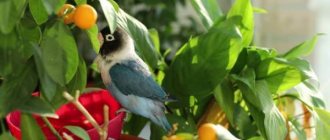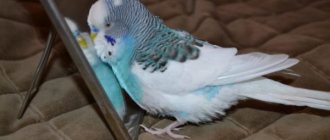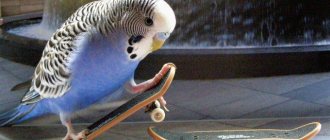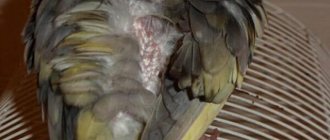Parrots are amazing pets. The acquisition of a feathered friend brings fun changes to the owner’s everyday life. To create comfortable conditions close to the bird’s homeland, it is necessary to diversify the methods of feeding the parrot.
One option is to create a “mudder”. In other words, it is a container with a selection of dry food in which the bird can walk and look for its favorite treat.
The “dry feeder” offers a variety of herbs, seeds, dried berries, small fruit twigs and pine cones as food. The composition may vary depending on the type of parrot. Large individuals prefer to see acorns, dried fruits, pumpkin or melon seeds, pieces of tree bark, dried mushrooms, lemon or orange zest in the “picker”. Small species of parrots eat chamomile flowers, plantain, chumiza, and nettle leaves with great pleasure.
Dry feeder for parrots
Hi all!
Today we’ll talk about DRY FEEDER. Yes, you heard right! Exactly about the dry feeder. Many parrot owners always provide their pets with a dry feeder every day. And I fully support them in this. A dry feeder is a kind of container (preferably large, so large that the bird can climb into it and rummage around) in which goodies, nibbles, dry seeds, nuts, nut shells, acorn caps, acorns, chestnuts are concentrated and mixed , cones, dry linden berries, dried citrus peels, pomegranate, dry carrots, dry branches, dried flowers, sticks, pieces of bark, pieces of clay or clay cakes..... In general, whatever you want is at your discretion. There is only one condition: the ingredients of the Dry Feeder must be DRY.)) My parrots also have such a feeder. In the photo: Dried calendula flowers Dried calendula seeds Dried hibiscus flowers Dry grass stems Dry berries (red and chokeberry, rose hips, blueberries) Pieces of apple tree bark Dry millet (at the bottom: getting it from the bottom is just a delight for birds; but just in feeder without a problem - no one is interested in it) Dried carrots
Digging in a dry feeder is not just eating, it is a most exciting activity for a bird. The parrot is busy for a long time. Busy with something he likes. He searches, digs, rakes... This is what parrots do in nature most of the time. Don't deprive your pets of this pleasure!!
You can change the composition of the dry “wealth” at your discretion. It is possible without flowers, if there are none. Add dry nut shells, cones, acorns, pieces of clay cakes, pieces of bark, various knots, nuts and pumpkin seeds. Just to get to the seeds, the parrot will climb there, dig and trample. He's interested. And it will be interesting for you to watch this from the side.
From my experience with cockatiels and rosella, I will say that they work and rummage in it for quite a long time. And they dig with such interest and knowledge of the matter!!
My birds' dry feeders are slightly different. Given the size of my birds, the bowl did not fit. Therefore, the containers are a tray from a cage or a basin. They must contain soil (naturally without mineral and chemical fertilizers), pieces of peat (we buy peat cups for seedlings), wood chips (you can buy wood chips for smoking - apple, cherry, etc.). Pieces of oak bark (required), ginger roots. Well, almost everything that is written above.
I like the soil with roots. We recruit in the forest specifically. By the way, I noticed that they really like to pick out sprouted onion sets and garlic. We also throw the entire overgrown sprout into that part of the basin, which we water a little at night.
Parrots can be frightened at first by an unfamiliar object, so for some long time the dry bowl was not in the cage at all. And on the windowsill. Within a couple of weeks the birds mastered it, fell in love with it and got used to it. And when they realized that the bowl was not the enemy, then I moved it next to the cage. Well, then little by little she began to place it on the bottom of the cage.
1- a mower hanging in a cage from a macaw and a Cuban Amazon by Natalia Yarovaya. 2 and 3 – dry mowing among cockatoos, Amazons, macaws, and Alexandrian parrots by Lyudmila Tikhnova. Ingredients: dried mushrooms and homemade charcoal, cocoa beans, coffee beans, all kinds of flowers and berries, bay leaves and other leaves.
Composition of the scythe for budgerigars and cockatiels by Vika Shibkova: charcoal, knotweed (knotweed) - domestic; bark with lichens; St. John's wort - pharmacy; plantain leaves - domestic; hibiscus flowers and rose petals - homemade; citrus zest; oak bark - pharmacy; chamomile - pharmacy; ears of wheat; Marigolds (calendula) - pharmacy; peppermint - pharmacy; coriander fruits - pharmacy; dried berries (viburnum, rowan, rose hips); pine needles; crushed sepia; Clay; eggshell; sesame; green buckwheat; Chumiza (I hid a little in a pine cone for the cockatiel); pine cone.
The parrots love it, they spend hours digging in the digger.
Dry feeder for Grays, from Alice Ioannou, the composition is as follows: Base: Mixed composition from the peel of watermelon, melon, pomegranate, orange and separately added: grapevine, eucalyptus bark, dried and fresh hawthorn fruits, dried rose hips, fresh green and ripe mastic pistachio fruits, cypress cones, green pine cones, sawed one into pieces, pink peppercorns, carob pods (carob) broken into pieces, eucalyptus fruit boxes, dried chili peppers (broken into pieces), sycamore cones and branches, acorns Palestine oak (Kaleprinsky), dry grenadilla peel, dried hibiscus flowers (Chinese rose), chopped pecans, walnuts, fennel seeds, dried mint, green bergamot fruits, fruit seeds: peach, apricot, plum, mango; shells and kernels of fresh almonds, dried mango peel, dried citrus peel Pomelo, watermelon seeds, dried mimosa flowers - topped with green pomegranate halves
Something like that. Maybe someone has another method/recipes of their own, please share! It will be useful to know other ways to interest crested animals.))
Creation of a "mower"
To create a “dry feeder” you will need to prepare a container in accordance with the size of the parrot. You can use a non-toxic plastic tray with low sides, a glass bowl with a wide, flat bottom, or a utensil tray. The main condition for selecting a container is the ability for the bird to completely climb into this feeder.
The desired ingredients are poured into the prepared bowl so that the bottom is completely covered.
The composition of the “mocker” can be filled from pharmaceutical herbs, such as:
- chamomile;
- nettle;
- milk thistle meal;
- calendula flowers and seeds;
- plantain leaves;
- Oak bark;
- hawthorn fruits;
- dry red rowan berries;
- dog-rose fruit.
As a supplement, you can offer the bird small branches of spruce, apple, apricot, and cherry. Sunflower or pumpkin seeds will be beneficial. The basic rule in creating a “mower” is exclusively dry food.
Fans of ornamental birds know how difficult it is to accustom a parrot to fruits and vegetables. We have to offer different product options. For example, by changing the shape of a piece of apple (cutting it into squares, slices, strips or on a grater), there is a hope that the bird will try the healthy fruit.
The important positive qualities of the “dry feeder” include not only an exciting activity for the pet, but also the receipt of necessary vitamins and nutrients for the bird’s body.
Natural instincts push the bird to look for the right food. Thus, the bird, rummaging among the useful components, finds tasty treats for itself.
Feeders, drinkers, baths, toys and perches for cockatiels
Feeders
Feeders are usually made of plastic and are available at any pet store, and they often come with the cage. The feeder should not have sharp edges or serifs. There are no special recommendations for feeders. Nymph feeders are usually installed so that the parrot has the opportunity to get food from the perch and does not have the opportunity to contaminate the food with droppings.
Drinking bowls
Drinkers are also made of plastic; so-called automatic drinkers are common, where the water stands in a column and flows out only when consumed. Sometimes parrots like to sleep on drinking bowls at night and by the morning you can find feces in the water. To prevent this from happening, improve the drinking bowl with a visor, it can be made from an old bank card and glued to the top of the drinking bowl. Any containers that are placed at the bottom of the cage are not recommended, as they become dirty very quickly.
Bathing suits
To bathe the nymph, you need a special bathing suit that is attached to the side door of the cage; any plate that matches the size of the cockatiel will also do, but again, it is not recommended to place it on the bottom of the cage; it is better to do this while walking. If your parrot doesn't want to bathe, you shouldn't force it. You can get out of this situation and spray the bird with a spray bottle, for which you need to pour very hot water into it, because... When sprayed, the water instantly cools (try it on your hand).
If the nymph gives in - goes towards the stream, then feel free to spray, if the parrot moves away, then you can splash over the cage, the water will fall on the bird. For some reason, bathing suits for cockatiels are a scarce item in pet stores (for wavy ones - please, but not for cockatiels) and often cost as much as half a cage, so I suggest making a bathing suit from a 6.5 liter plastic food container (see photo) cheaply and angrily, and the parrot will only be grateful to you, it’s better to buy him a tasty treat with the money you saved.
Toys You can write a lot about toys for cockatiels, but I will give only the main points. The inside of the cage should not be overloaded with toys; it is better to hang the outside of the cage and the supercellular space with all sorts of devices. Toys must be safe, namely: not contain toxic substances or dyes, and not have small parts that a nymph can swallow.
Various ropes and their braided derivatives are very popular in production; it is recommended to refrain from them, because... a parrot can get its claw caught in a trap and twist its finger, so it is better to replace all ropes with chains. When buying or making new toys, do not rush to hang them in the cage; it is better to hang them near the cage or in the parrot’s play corner so that the bird has the opportunity to get used to the new toy. If your bird lives alone, take care of its leisure time, in this case you simply must build a play corner for your cockatiel, believe me, it will be interesting for you and your children, and the parrot will be very grateful to you. Don’t forget to show the parrot exactly how to play with the toy: shake it, ring it, rattle all the rattles, etc. Many nymphs are not indifferent to shiny things, like magpies, so remember about long-forgotten decorations, perhaps they will bring a lot of joy to the parrot (remember about small parts, beads, pebbles, etc.)
How to arrange and where to place
To make a parrot scoop with your own hands, you can take any flat and not too deep container - a bowl, a tray with high (5 cm is enough) sides, a tray, a tray from an old cage. This bird entertainment needs walls so that the contents from the parrot’s activities do not scatter around the room.
The scythe is usually placed at the bottom of the cage, aviary or attached to the walls, but taking into account the fact that the vessel will support the weight of the parrot’s body and will not break or tip over. A small dry feeder can be placed in a cage occupied by one pet.
A large-capacity bowl or tray can be easily installed outside the bird’s house, on any flat surface. The main thing is that it is clearly visible from all points of the room. A good location for a picker can be considered near a play stand or a place that birds have chosen to rest. To attract their interest at the initial stage, you can do this: put inside some bright toy that is well known to the birds - a rattle or a mirror.












